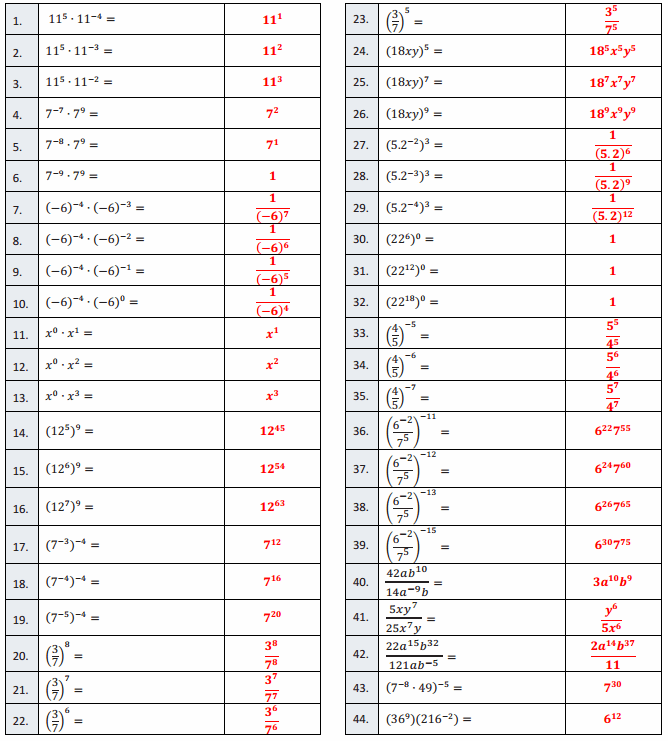Engage NY Eureka Math 8th Grade Module 1 Lesson 8 Answer Key
Eureka Math Grade 8 Module 1 Lesson 8 Example Answer Key
Example 1.
In 1723, the population of New York City was approximately 7,248. By 1870, almost 150 years later, the population had grown to 942,292. We want to determine approximately how many times greater the population was in 1870 compared to 1723.
The word approximately in the question lets us know that we do not need to find a precise answer, so we approximate both populations as powers of 10.
→ Population in 1723: 7248<9999<10000=104
→ Population in 1870: 942 292<999 999<1 000 000=106
We want to compare the population in 1870 to the population in 1723:
\(\frac{10^{6}}{10^{4}}\)
Now we can use what we know about the laws of exponents to simplify the expression and answer the question:
\(\frac{10^{6}}{10^{4}}\) =102.
Therefore, there were approximately 100 times more people in New York City in 1870 compared to 1723.
Example 2.
Let’s compare the population of New York City to the population of New York State. Specifically, let’s find out how many times greater the population of New York State is compared to that of New York City.
The population of New York City is 8,336,697. Let’s round this number to the nearest million; this gives us 8,000,000. Written as single-digit integer times a power of 10:
8 000 000=8×106.
The population of New York State is 19,570,261. Rounding to the nearest million gives us 20,000,000. Written as a single-digit integer times a power of 10:
20 000 000=2×107.
To estimate the difference in size we compare state population to city population:
\(\frac{2 \times 10^{7}}{8 \times 10^{6}}\)
Now we simplify the expression to find the answer:
\(\frac{2 \times 10^{7}}{8 \times 10^{6}}\) = \(\frac{2}{8}\) × \(\frac{10^{7}}{10^{6}}\)By the product formula
= \(\frac{1}{4}\)×10 By equivalent fractions and the first law of exponents
=0.25×10
=2.5
Therefore, the population of the state is 2.5 times that of the city.
Example 3.
There are about 9 billion devices connected to the Internet. If a wireless router can support 300 devices, about how many wireless routers are necessary to connect all 9 billion devices wirelessly?
Because 9 billion is a very large number, we should express it as a single-digit integer times a power of 10.
9 000 000 000=9×109
The laws of exponents tells us that our calculations will be easier if we also express 300 as a single-digit integer times a power of 10, even though 300 is much smaller.
300=3×102
We want to know how many wireless routers are necessary to support 9 billion devices, so we must divide
\(\frac{9 \times 10^{9}}{3 \times 10^{2}}\)
Now, we can simplify the expression to find the answer:
\(\frac{9 \times 10^{9}}{3 \times 10^{2}}\) = \(\frac{9}{3}\) × \(\frac{10^{9}}{10^{2}}\) By the product formula
=3×107 By equivalent fractions and the first law of exponents
=30 000 000
About 30 million routers are necessary to connect all devices wirelessly.
Example 4.
The average American household spends about $40,000 each year. If there are about 1×〖10〗8 households, what is the total amount of money spent by American households in one year?
Let’s express $40,000 as a single-digit integer times a power of 10.
40000=4×〖10〗4
The question asks us how much money all American households spend in one year, which means that we need to multiply the amount spent by one household by the total number of households:
(4×104 )(1×108 )=(4×1)(104×108 ) By repeated use of associative and commutative properties
=4×1012 By the first law of exponents
Therefore, American households spend about $4,000,000,000,000 each year altogether!
Eureka Math Grade 8 Module 1 Lesson 8 Exercise Answer Key
Exercise 1.
The Federal Reserve states that the average household in January of 2013 had $7,122 in credit card debt. About how many times greater is the U.S. national debt, which is $16,755,133,009,522? Rewrite each number to the nearest power of 10 that exceeds it, and then compare.
Answer:
Household debt=7122<9999<10000=104.
U.S.debt =16 755 133 009 522<99 999 999 999 999<100 000 000 000 000=1014.
\(\frac{10^{14}}{10^{4}}\) = 1014-4=1010. The U.S. national debt is 1010 times greater than the average household’s credit card debt.
Exercise 2.
There are about 3,000,000 students attending school, kindergarten through Grade 12, in New York. Express the number of students as a single-digit integer times a power of 10.
Answer:
3 000 000=3×106
The average number of students attending a middle school in New York is 8×〖10〗2. How many times greater is the overall number of K–12 students compared to the average number of middle school students?
Answer:
\(\frac{3 \times 10^{6}}{8 \times 10^{2}}\)= \(\frac{3}{8}\)×\(\frac{10^{6}}{10^{2}}\)
= \(\frac{3}{8}\)×\(\frac{10^{6}}{10^{2}}\)
=0.375×〖10〗4
=3750
There are about 3,750 times more students in K–12 compared to the number of students in middle school.
Exercise 3.
A conservative estimate of the number of stars in the universe is 6×1022. The average human can see about 3,000 stars at night with his naked eye. About how many times more stars are there in the universe compared to the stars a human can actually see?
Answer:
\(\frac{6 \times 10^{22}}{3 \times 10^{3}}\) = \(\frac{6}{3}\) ×\(\frac{10^{22}}{10^{3}}\)= 2×1022-3 = 2×1019
There are about 2×1019 times more stars in the universe compared to the number we can actually see.
Exercise 4.
The estimated world population in 2011 was 7×109. Of the total population, 682 million of those people were left-handed. Approximately what percentage of the world population is left-handed according to the 2011 estimation?
Answer:
682 000 000≈700 000 000=7×108
\(\frac{7 \times 10^{8}}{7 \times 10^{9}}\)=\(\frac{7}{7}\)×\(\frac{10^{8}}{10^{9}}\)
= 1×\(\frac{1}{10}\)
=\(\frac{1}{10}\)
About one-tenth of the population is left-handed, which is equal to 10%.
Exercise 5
The average person takes about 30,000 breaths per day. Express this number as a single-digit integer times a power of 10.
Answer:
30000=3×104
If the average American lives about 80 years (or about 30,000 days), how many total breaths will a person take in her lifetime?
Answer:
(3×104 )×(3×104 )=9×108
The average American takes about 900,000,000 breaths in a lifetime.
Eureka Math Grade 8 Module 1 Lesson 8 Problem Set Answer Key
Students practice estimating size of quantities and performing operations on numbers written in the form of a single-digit integer times a power of 10.
Question 1.
The Atlantic Ocean region contains approximately 2×1016 gallons of water. Lake Ontario has approximately 8,000,000,000,000 gallons of water. How many Lake Ontarios would it take to fill the Atlantic Ocean region in terms of gallons of water?
Answer:
8 000 000 000 000=8×1012
\(\frac{2 \times 10^{16}}{8 \times 10^{12}}\)=\(\frac{2}{8}\)×\(\frac{10^{16}}{10^{12}}\)
=\(\frac{1}{4}\)×104
=0.25×104
=2500
2,500 Lake Ontario’s would be needed to fill the Atlantic Ocean region.
Question 2.
U.S. national forests cover approximately 300,000 square miles. Conservationists want the total square footage of forests to be 300,000〗2 square miles. When Ivanna used her phone to do the calculation, her screen showed the following:
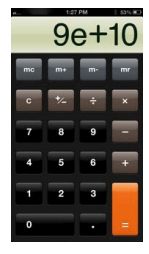
a. What does the answer on her screen mean? Explain how you know.
Answer:
The answer means 9×1010. This is because:
(300 000)2=(3×105)2
=32×(105 )2
=9×1010
b. Given that the U.S. has approximately 4 million square miles of land, is this a reasonable goal for conservationists? Explain.
Answer:
4 000 000=4×106. It is unreasonable for conservationists to think the current square mileage of forests could increase that much because that number is greater than the number that represents the total number of square miles in the U.S,
9×1010>4×106.
Question 3.
The average American is responsible for about 20,000 kilograms of carbon emission pollution each year. Express this number as a single-digit integer times a power of 10.
Answer:
20 000=2×104
Question 4.
The United Kingdom is responsible for about 1× 104 kilograms of carbon emission pollution each year. Which country is responsible for greater carbon emission pollution each year? By how much?
Answer:
2× 104>1×104
America is responsible for greater carbon emission pollution each year. America produces twice the amount of the U.K. pollution.
Eureka Math Grade 8 Module 1 Lesson 8 Exit Ticket Answer Key
Most English-speaking countries use the short-scale naming system, in which a trillion is expressed as 1,000,000,000,000. Some other countries use the long-scale naming system, in which a trillion is expressed as 1,000,000,000,000,000,000,000. Express each number as a single-digit integer times a power of ten. How many times greater is the long-scale naming system than the short-scale?
Answer:
1 000 000 000 000=1012
1 000 000 000 000 000 000 000= 1021
\(\frac{10^{21}}{10^{12}}\) = 109. The long-scale is about 109 times greater than the short-scale.
Eureka Math Grade 8 Module 1 Lesson 8 Sprint Answer Key
Applying Properties of Exponents to Generate Equivalent Expressions—Round 1
Directions: Simplify each expression using the laws of exponents. Use the least number of bases possible and only positive exponents. When appropriate, express answers without parentheses or as equal to 1. All letters denote numbers.
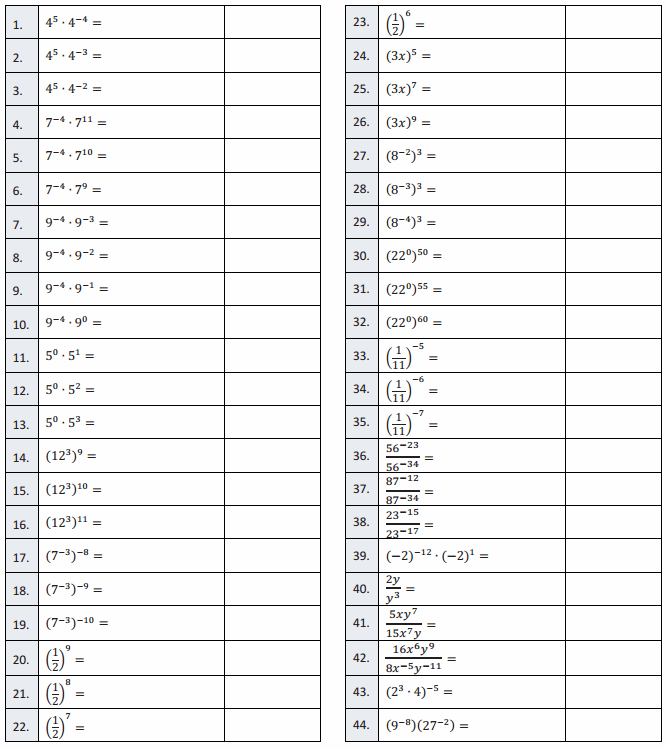
Answer:
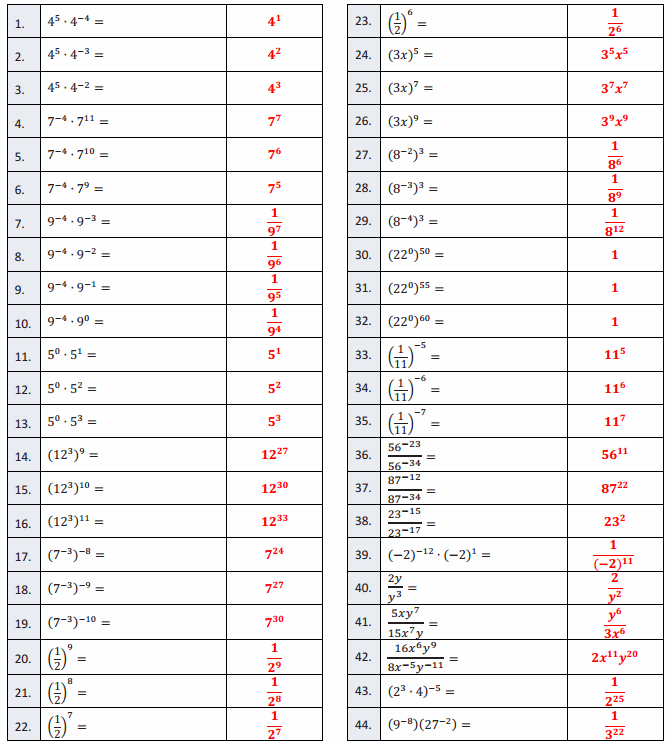
Applying Properties of Exponents to Generate Equivalent Expressions—Round 2
Directions: Simplify each expression using the laws of exponents. Use the least number of bases possible and only positive exponents. When appropriate, express answers without parentheses or as equal to 1. All letters denote numbers.
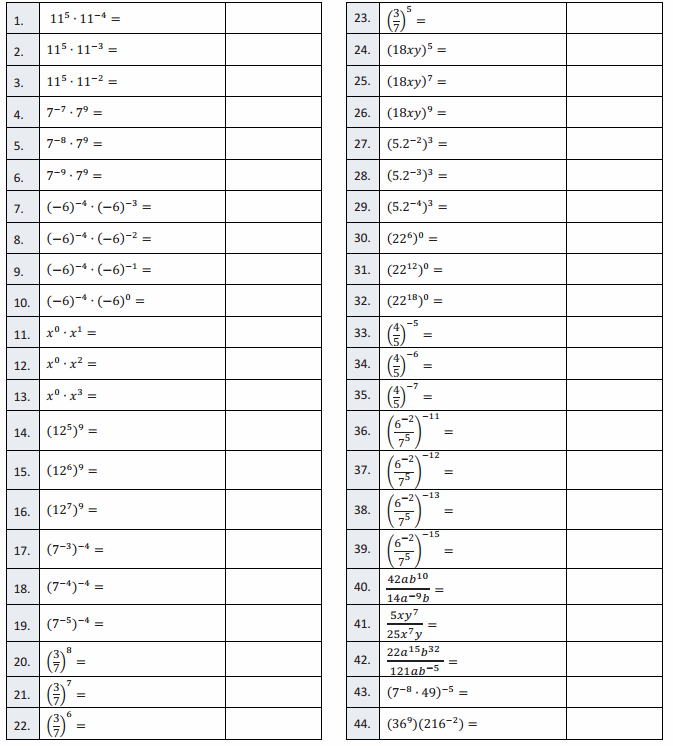
Answer:
